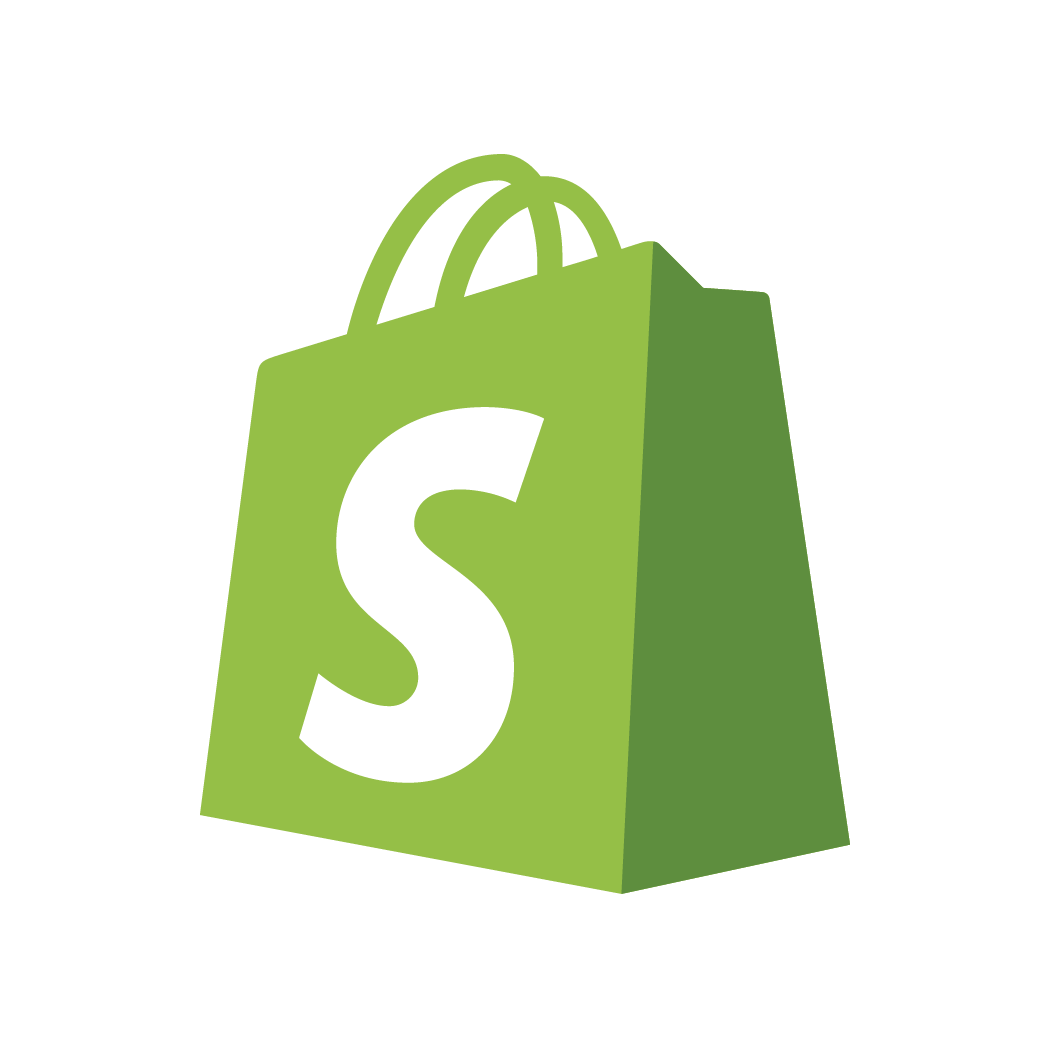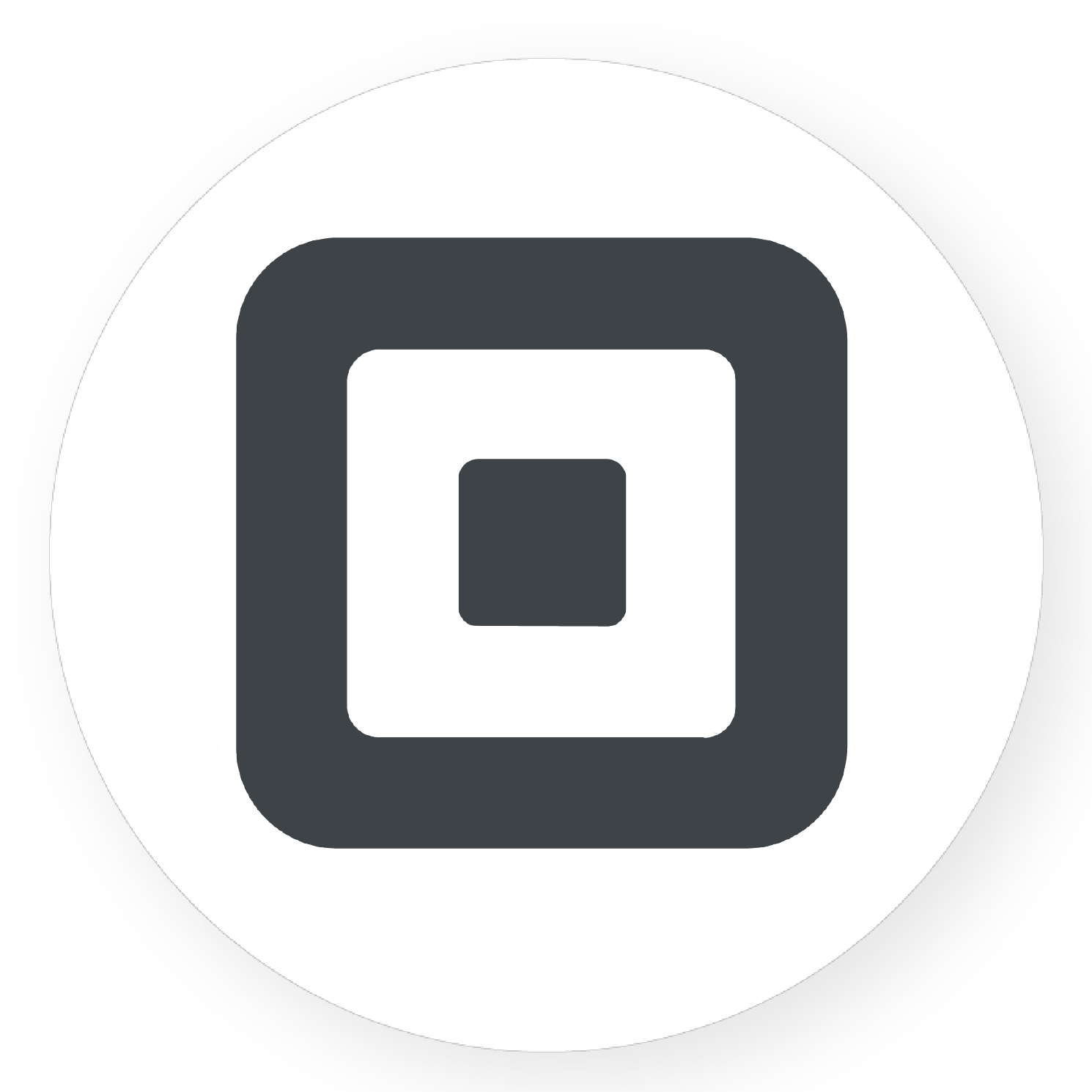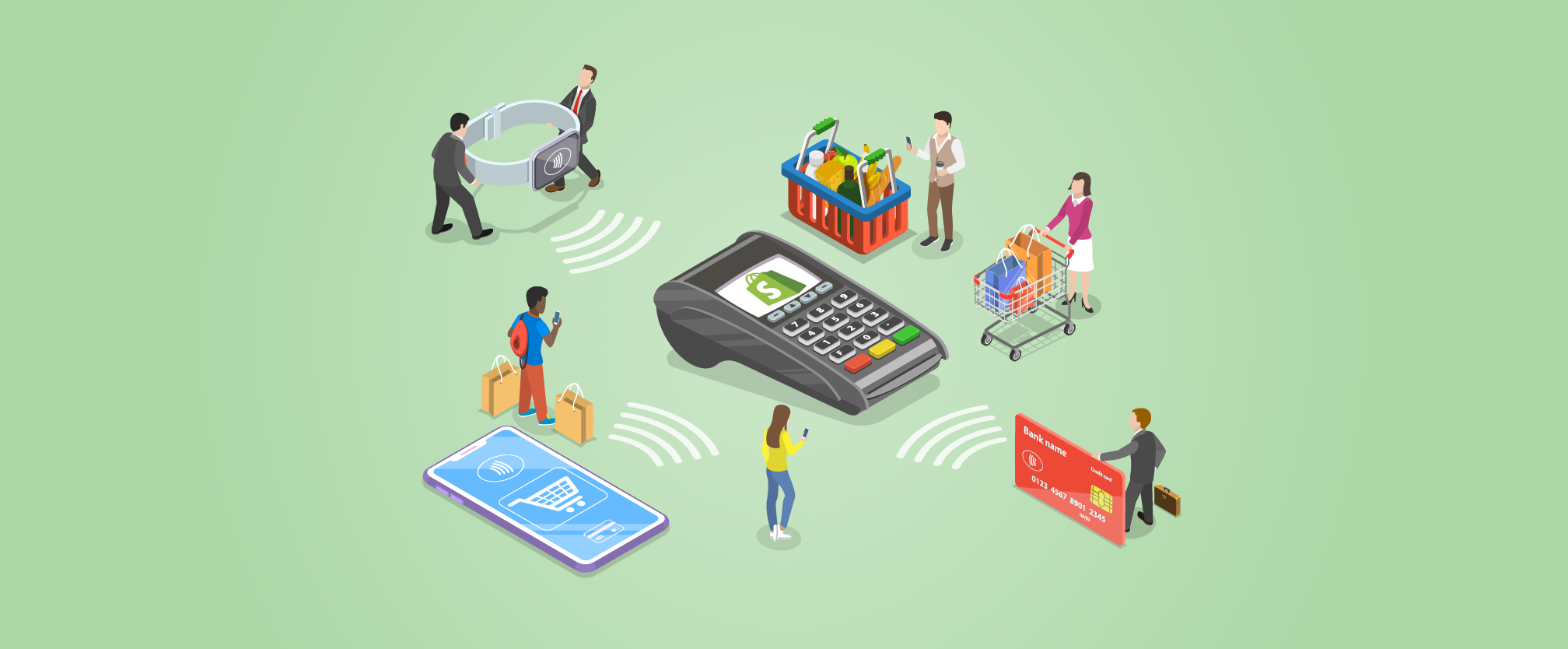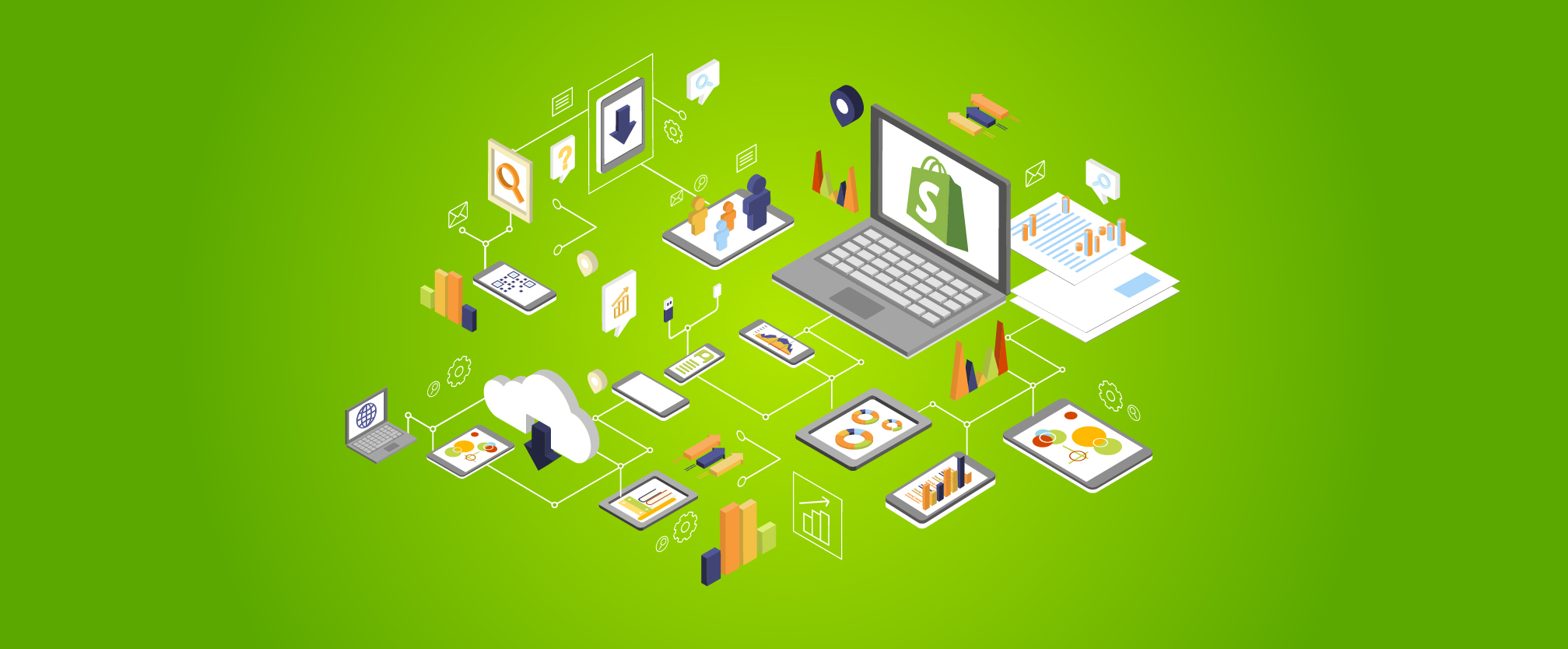The eCommerce POS integration not only gives your consumers a seamless shopping experience but also helps you manage your business more efficiently. Customer management, inventory, eCommerce, security, reporting, and other features are all available in POS software. Retailers want it linked, but getting the correct set of Shopify extensions is proving challenging. They may not be appropriate for your existing module, or you may want to install additional applications. As a result, our article will provide some helpful guidelines for choosing the best POS system suitable for your Shopify store.
What is Shopify?
Shopify is a commerce platform that allows anyone to set up an online store and sell their products. Merchants can also sell their products in person with Shopify POS.
Shopify is now the leading commerce platform designed for businesses of all sizes. Whether you sell online, on social media, in-store, or out of the trunk of your car, Shopify has you covered. The first Shopify store was our own, and it’s been our mission to make commerce better for everyone ever since.
What is a retail POS system?

A point-of-sale (POS) system is the hardware and software that lets you check out customers, accept payments, and manage your physical retail stores.
POS systems are now widely used by many businesses in different countries and industries, especially those building omnichannel shopping experiences. In fact, research has forecast that the global POS software market will rise to $42.5 billion by 2027.
A POS system is made up of three parts:
-
- Software
-
- Hardware
-
- Payments
Software
POS software is the operating system used to ring up sales and manage your store, products, customers, and staff.
Most point-of-sale software providers give various subscription options at different price ranges. While the lower-cost plans provide all you need to sell in person, the higher-priced plans usually include more advanced features.
Modern POS software, such as Shopify POS, is designed for retailers that sell online and in-person, including unified multi-channel sales reporting, customer purchase history, inventory management, order fulfillment, etc.
Hardware
To accept payments, you’ll need POS hardware. Make sure that the new POS system you select can accept all payment options, including cash, credit and debit cards, mobile payments such as Apple Pay or Google Pay, and gift cards.
Depending on which payment methods you want your POS system to accept, you’ll need a cash register, tap-and-chip card reader, cash drawer, and bar-code scanner.
Payments
POS systems also take care of routing funds to your bank account after each sale. But if the POS system has integrated payment processing, you can avoid paying third-party payment processing fees, know when to expect payouts, and track in-store and online sales and payments from the same back office.
What are the benefits of a retail POS system?
The best retail POS systems come with features that make running your store easier. A few benefits include:
-
- Mobile checkout
-
- Secure payments
-
- Multi-location inventory management
-
- Easy to use
-
- Customizable
Mobile checkout
Retail POS software is often installable on any iOS or Android tablet or smartphone. This software allows store staff to serve consumers anywhere in the store, receive payments, and check them out on the spot.
One of the most obvious advantages of mobile checkout is that consumers may receive one-on-one service from staff, and staff have the information they need to provide individualized service at their fingertips.
For example, with Shopify POS, staff may check up on a shopper’s purchase history to ensure the things they propose match their interests and preferences. If the shopper has a favorite color, the shop staff can add a note to the customer’s profile so that context is shared with any store associate who serves them in the future.
Mobile POS systems also make it easier for shop staff to service more than one client at a time. This is extremely helpful if your shop has a small team or often serves a high volume of customers.
Secure payments
Retail point-of-sale systems with integrated payment processing should be able to process credit card transactions both in-store and online.
Confirm that your payment provider is dedicated to protecting your payment information and essential business data. For example, Shopify Payments is included in all Shopify POS plans and has PCI-compliant servers, payment data encryption, and 3D secure checkouts.
Multi-location inventory management
A retail POS system allows you to manage multiple store locations without the need for different systems.
At a minimum, your retail POS system should allow you to easily transfer stock from one shop to another or from your warehouse to a store without the need to alter stock quantities once the inventory is received manually.
A retail POS system can tap into your sales data and provide smart suggestions for which stock to include in your next purchase order and manage the inventory you already have. For example, Shopify POS suggests purchase orders based on product sales and seasonality per store location. You may also set reorder points and receive notifications when a product runs out of stock in one of your stores.
Along with inventory management, the best retail POS system changes stock quantities automatically when a stock moves between stores and your warehouse.
See more: Complete Guide for Beginners: Manage Shopify Multiple Locations from a single order
Easy to use
When selecting a retail POS system, make sure it is simple and intuitive. This reduces the amount of time you spend learning how to use it and allows you to onboard new staff more quickly.
Any store POS system worth considering should provide a free trial period. Before making any financial commitments, make sure you’re comfortable with the interface and like using the POS.
Customizable
While we recommend choosing a POS system with the features and capabilities you require right out of the box, it’s equally important to consider how customizable it is. After all, your business needs are likely to change as it evolves and customer habits and preferences change.
You may enhance the functionality of your POS system with Shopify by adding applications from the Shopify App Store. These applications may help you with marketing, bookkeeping, scheduling, and almost any other aspect of operating a business and generating sales. You may add shortcuts to your home screen to access functions without leaving Shopify POS, rather than switching from one software to another.
Factors to consider when choosing a POS system
Whether you’re opening your first store or are thinking of switching from your current point-of-sale system, here are some key factors to consider when choosing the best POS system for your business:
POS software fees
First things first: your POS system must be within your budget. But several factors can impact the price of a POS system. The first is POS software fees.
Most POS software has either a monthly fee or an annual fee and different plan tiers at different price points. Higher-tier plans typically have more advanced features.
For example, each online merchant on Shopify’s Basic account receives free Shopify POS software including everything they need for in-person selling at pop-up shops and events.
For $89 per month, per shop location, merchants with permanent store locations may sign up for Shopify POS Pro, which includes comprehensive reporting and analytics as well as additional control over staff accounts and user rights.
Hardware costs
The second thing you should factor is hardware costs and functionality. The hardware cost varies based on your demands, the forms of payments you wish to take, and the number of businesses and employees you have.
You can buy, lease, or rent POS hardware depending on your needs. If you’re creating a pop-up shop, for example, renting rather than buying POS hardware makes more sense.
Consider the hardware and features you’ll need to run your business, then compare the POS providers’ offerings to discover the greatest value.
Payment processing fees
Consider payment processing expenses and the cost of your POS system’s payment hardware.
Your credit card processor will charge you a fee each time you complete a sale. This cost is charged each transaction as a hidden fee as well as a monthly fee. The amount you pay for each transaction is determined by the customer’s credit card in many situations.
Check if your point of sale provider supports integrated payment processing before choosing a payment processor. For instance, all Shopify POS options include Shopify Payments, and there are no registration or setup fees. Get faster payments and greater management of your cash flow by paying the same pre-negotiated rate for all credit cards, beginning at 2.4% + $0.
Mobility
Modern POS systems, such as Shopify POS, are mobile, allowing you to sell wherever your clients are. Mobile checkout is becoming standard in retail since it reduces payment wait times and improves store circulation, especially at the checkout counter.
Order fulfillment options
Customers today want the freedom to purchase how they want. Whether a customer purchases online, in-store, or through a combination of channels, businesses must make the process as simple as possible.
When your POS system and e-commerce platform work together, you can provide more flexible order fulfillment options like purchasing online, pick up in-store (BOPIS), and home delivery to your customers, as well as a more convenient shopping experience.
E-Commerce platform integration
Using separate systems to handle online and physical stores resulted in a confusing consumer experience, with little annoyances like not being able to use digital gift cards in-store to more big troubles like inventory visibility across locations.
Shop owners require real-time access to goods and inventory to manage their shops and better serve their consumers. Because the information is updated instantly and automatically across online and physical stores, managing inventories through an integrated system will assist you in reaching your goals.
With our middleware platform – Hexasync, you can easily automate and optimize your POS operation, allowing your company to focus on effectiveness and income rather than activities like updating inventory information and processing orders and refunds.
POS software features
Aside from basic features like accepting payments, the best POS systems will also include the following:
-
- Integrated payment processing
-
- Centralized reporting and analytics
-
- Multichannel inventory management
-
- Staff management
-
- Flexible order fulfillment
-
- Multi-store management
-
- Customer relationship management
Customer support
The best POS systems also have the best customer support available via email, chat, or phone. When selecting a POS system, ensure the support is free and available anytime you need it.
How to choose the best retail POS system?
Whether you’re considering switching from an existing point-of-sale system or starting your first store, here are some guidelines for selecting the right POS for your business’s needs now.
List your business activities
Before you start shopping for POS systems, make a list of your most important business activities and what you need your POS system to do. If you’re considering switching from another POS system, make a list of your problems and how POS features may help you solve them.
Also, consider where you want your company to be in five to ten years. What tools will you need to help you achieve your goals? Consider this immediately to ensure you select a POS system that will grow with your company as its demands change.
Consider the data you need
Data enables you to make intelligent decisions, take opportunities, and prevent costly errors. We recommend that you list the data you need to run your business in the same way that you describe your business activities and goals.
What information do you require at the end of each day, the end of the month, or the end of the year? What information would you want to have? Determine which retail metrics are essential to you and make sure your POS system’s reports include them.
Consider data like customers’ online and in-store purchase histories or which goods contribute to the highest (and lowest) percentage of revenue, in addition to what you need to manage day-to-day operations.
Know which payment types you want to accept
Consider which payment methods your POS system should accept. How do you want your consumers to pay?
Apart from the most popular payment methods (cash, debit, and credit cards), COVID-19 has seen an increase in mobile wallet usage. In fact, 64% of customers polled now use mobile wallets to pay for things in 2020, up from only 38% in 2019.
When deciding which POS system to use, be sure it supports the payment types you need and that the payment processing rates are within your budget.
Figure out what POS hardware you need
You may start thinking about the POS hardware you’ll need once you’ve decided on the payment methods you’ll accept. While most POS providers will gladly guide you through your hardware options, we recommend that you have a general idea of what you need ahead of time.
Compare different POS systems
Now that you know exactly what you need to run your business today and in the future, you’re ready to start looking for a POS provider.
Research review sites, speak with other retailers, and learn which POS systems top businesses use. Also, visit each POS provider’s website to learn more about their services.
Once you’ve narrowed down your selections and want to test how their POS system works, sign up for a free trial to see whether it meets your requirements. Before making any financial commitments, you may try out the features and see how simple it is to use.
What is the best POS system suitable for the Shopify platform?
Lightspeed Retail – Best for large businesses
Lightspeed is a well-known POS business that focuses on retail, restaurants, and golf. This solution is a leading branch of Lightspeed with powerful features for large companies. They go after chain retailers and other businesses with more than one location.
As a result, Lightspeed Retail is proud of its broad management tools, which include:
-
- Inventory management: Sort your products by different variants quickly (such as colors, origins, sizes, etc.).
-
- Employee management: Keep track of staff’s sales records and assign permissions to a specific part of your POS system.
-
- Customer relationship management (CRM): Use customer profiles and other marketing tools to engage with your customers.
-
- Reporting and analytics: Understand your business better.
-
- ECommerce integrations: Manage all of your online stores from a single POS
Lightspeed is suitable for large businesses with more budgets. This is because advanced features require a more expensive subscription.
Lightspeed Retail’s lowest plan for annual bills is $69/month (Lean), plus a card-present rate of 2.6% + 10¢. The more advanced options are $119/month (Standard) and $199/month (Advanced). Meanwhile, monthly billing is slightly higher in price. However, if you are looking for a POS system that is exceptionally powerful in management, Lightspeed can be a good option.
Vend – Best for medium-sized companies
Vend is the next POS system that we would suggest to our readers. Vend is suitable for medium-sized businesses with a focus on physical stores. This is due to Vend’s lack of native eCommerce capabilities.
The most highlighted feature of Vend is inventory management. This POS system includes inventory management features like supplier data, stock levels, sales records, low-stock notifications, etc. Aside from these functionalities, Vend also allows customers to import product lists into the system through an Excel file. Users may then use this information on both online and offline channels to make changes.
Vend also has the following significant features:
-
- Loyalty functions
-
- Offline mode
-
- Reporting
-
- Compatibility with multiple devices, including PCs, iPad, and mobiles
-
- No extra transactional fee
Regarding pricing, Vend like Lightspeed is on the more expensive side. This POS provider offers 3 types of subscriptions. They are the Lite ($99/month), Pro ($129/month), and Enterprise (customizable price) versions. For the above functions, Vend is an ideal option for inventory-rich businesses and not so suitable for service-based companies.
Square – Best for newly-opened businesses
Square is another reputable name in the POS industry because of its broad range of applications. Square provides this POS for Retail, a retail-focused offshoot. The free edition of Square’s point-of-sale software offers a significant benefit. As a result, it is suitable for start-ups that are still in the early stages of development and just require basic management tools. However, if you want more advanced functionality, alternative options are available, which we will discuss later.
Here are some other Square features to consider:
-
- Built-in payment processing
-
- Barcode-based interface, including barcode creation, purchase orders, etc.
-
- User-friendly dashboard
-
- Online store creation (build a free website/online shop for delivery or pickup)
-
- Customer relationship management (CRM) tools
Aside from the free version, Square for Retail currently offers a Plus version with more advanced features for $60/month/location, plus a transaction processing cost. A Premium plan with customized pricing is also available.
Above all, Square’s free version and ease of use are its two biggest advantages. As a result, it is an excellent POS choice for newly established businesses.
Clover – Best for simple setup
Clover is another POS system for retail businesses. Unlike the POS described above, Clover is well-known for its hardware. The software runs smoothly on these devices and gives retailers a pleasant experience.
Clover is a powerful software option for businesses seeking a quick setup. Merchant services are pre-programmed into the Clover app. As a result, if you want to modernize your cash register while keeping your current merchant account, Clover is the way to go.
Some outstanding features of Clover are:
-
- Mobile POS: suitable for both iOS and Android
-
- Employee management: Assign permissions to specific data to several employees
-
- Customer management tools: track customers’ previous transactions, create customer profiles, manage loyalty programs, etc.
-
- More than 200 apps and add-ons: complete your business needs by integrating other integrations, namely inventory management, accounting, invoicing, and so on
Clover may easily be turned into an All-in-One app for your business by leaving space for multiple add-ons.
Clover is currently offering different pricing plans, depending on your purpose of use. For example, there are:
-
- Payments plan (with no POS functions): with the flat-rate processing of 2.6% + $0.10 for businesses
-
- Essentials plan: for businesses with credit card sales below $50,000/year – $9,95/month/additional device
-
- Register plan: for businesses with credit card sales above $50,000/year – $9,95/month/additional device
Hexasync – the integrated solution any POS system with your Shopify store
Our Hexasync Integration Platform makes it easy to integrate Shopify with any POS system. Allows you to sync inventory, orders, and customers between Shopify and your POS.
Beehexa uses the latest technologies and optimizations in the industry to provide you with Hexasync – a real-time data sync and monitoring middleware. Hexasync provides data integrity protections, as well as tile-based mapping to ensure reliable synchronization between your Shopify store and your POS applications.
Some of the fields from the POS system that can be integrated with Shopify include Item Name, Inventory, Variant Name, Price, SKU, Description, and Image. Also, the fields that sync from Shopify to the POS system include Title, Inventory, Color/Shadow, Price/Compare by Price, Product Line, Description, and Image.
The following are some of Hexasync’s features when compared to competing solutions::
-
- Middleware: an application-independent lightweight piece of software that handles all the intricacies of integration
-
- EAV design pattern: combined to allow more flexibility in data modeling
-
- Message Queuing-Based Architecture: simplifies the coding of detached applications and provides better performance, reliability, and scalability
-
- Customizable handler: allows for better visibility of your customer’s order status
-
- Cell-based mapping: highly accurate single-cell data mapping for reliable synchronization
-
- Asynchronous integration: keep your business up to date with real-time sync
-
- Compatible with POS Apps: Connect your Shopify storefront to any POS app easily
Conclusion
We hope that this article has given you some helpful advice on choosing the best point-of-sale system for your Shopify store. Because each POS system has unique advantages, we recommend that you analyze your specific problems while selecting the best solutions for your company. That solution should allow you to sell the way consumers buy and run your business with confidence.
If you need advice and a demo of integrated POS solutions, do not hesitate to contact us immediately. We will schedule an appointment as soon as possible to answer all your questions about the problems for integrated solutions and suggest the most suitable solution for your business.









